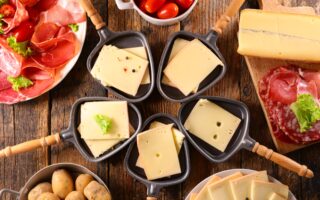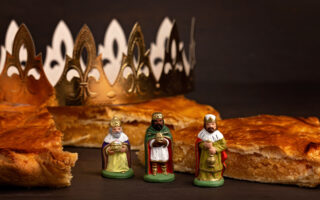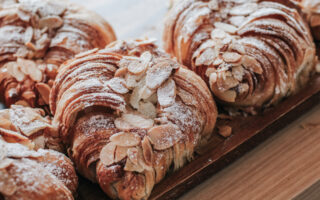Regional Products from the South of France

Under the charm of the Lot and Quercy region
The Lot region in the South of France hides a wealth of treasures just waiting to be discovered. The relaxed and pleasant lifestyle works like a charm on visitors, and has induced many to settle here. Part of the attraction is undoubtedly the quality of the local products, and the skill with which they are blended into delicious dishes.
Cahors Wine
Cahors wine is dark red, and gives off scents of red berry fruits, and sometimes of liquorice. It is rich, tannic, robust, full-flavoured and as it ages, develops delicate and complex aromas.
Auxerrois is the principal grape variety used to make this wine, which, in recent years, has scaled the heights of the great wines, thanks to the enthusiasm and efforts of the wine-growers of the area.
Many of the vineyards are open to the public, allowing you to sample the different vintages first hand in a petite dégustation. The growers are proud of their work and will delight in telling you about the different parts of the vineyard, the sunshine and the soil types. See The Black Wine of Cahors for some personal recommendations.
Truffles
This heavenly mushroom, which grows only in certain limestone soils and under certain oak trees and is sold in up market restaurants for a King’s ransom, is justly prized. Simply storing one for a while with fresh eggs imparts an incomparable flavour. With meat or fish, they are always a success.
If truffle plantations are jealously guarded, there are wild ones to be found. And, should you not have a truffle pig or dog to hand, a little fly buzzing around at the foot of the oaks is often a sign of its presence.
In any case, you should walk round the market in Lalbenque, held from December to March, just to catch the scent of this unique flavoursome fungus.
 Chestnuts
Chestnuts
Not as well known as it deserves, the chestnut has a little quiff reminiscent of Tintin. Have you ever tried them cooked the traditional way? Split with a knife, put in an earthenware pot placed in the heart of the fire. When the brown outer skin is removed, the chestnut has a lovely yellow colour. Top with a knob of butter or duck fat and enjoy.
Foie Gras
The first evidence of the existence of foie gras goes back 4,000 years, to the banks of the Nile. There, farmers had already discovered the delights of eating wild ducks and geese, and their livers.
Brought to the South of France by the Romans, foie gras found a perfect home in the Lot. Fresh foie gras lightly fried (the pan juices deglazed with raspberry vinegar or walnut wine); enjoy it with a slice of country bread grilled over a wood fire.
Quercy Lamb
Sheltering behind the dry stone walls on the Causses de Quercy in south west France there are large flocks of a special breed of sheep with “sunglasses” (black circles round their eyes) whose quality is so well recognised that they were the first in France to be awarded a “label” for their lamb (“Label Rouge”, which is only awarded on average to one animal in two – only 56,000 lambs per year, but a guarantee of superior quality). Quality due not only to the breed, but also to the way they are raised; fed mostly by their mothers, they are also given some cereals. The beautiful pink meat melts in the mouth.
 Quercy Melon
Quercy Melon
When the summer is at its hottest, when life seems to be suspended, when no cool shade is to be found, then thousands of green and yellow cannon balls suddenly ripen, bursting with sugar and sunshine. The excellent situation of the Causses, and their thin clay soil give a wonderful concentration of flavour to the flesh of melons from the Quercy.
Serve them plain, in gazpacho, with a cream made with walnut oil, as an accompaniment to duck, in sorbets, with port poured inside or in charlottes, filled with soft fruits. Quercy Melons are full of delightful surprises.
Plums
The Entes plum is a variety only to be found here. Dried, it becomes a prune. When fresh, it is juicy, firm and full of flavour. Look for those that are slightly overripe, as they are the best. The preserved variety develops a hint of marzipan.
 Rocamadour Goats’ Cheese
Rocamadour Goats’ Cheese
Formerly known as Cabécou, this goats’ cheese from the famous home of the Black Virgin has been made here since the 15th century. It is undoubtedly one of the oldest traditional products of the Lot.
Awarded Appellation d’Origine Contrôlée status, Rocamadour is a tasty little cheese which can be eaten young; after only 5 to 8 days. It is pale yellow on the outside and creamy on the inside, with a subtle flavour. However, it can also be kept in a cellar for a week or two, time for the outside to become dry, a few blue spots to appear, and a stronger flavour to develop. Whether young or old, a Rocamadour cheese is best appreciated with fresh bread and a ruby red Cahors wine.
 Saffron
Saffron
From mid-October to mid-November, a marvellous sight is to be seen: fields of mauve, from which, picked by hand, comes a wonderful scented golden treasure, grown and used for 2000 years in the Lot.
This treasure is the stigmata of the style of the Crocus sativus L, more commonly known as saffron. Although expensive to buy a tiny pinch is all that is needed to colour and flavour all kinds of food.
 Walnuts
Walnuts
Walnut trees like the conditions in the Lot; they are at home here, and can be seen everywhere. Every village has its walnut-oil mill and long rows of these beautiful big-leaved trees can be seen everywhere.
Walnuts appear in many guises; chopped in salad, included in cakes, covered in delicious dark chocolate. Or perfectly plain, at the end of a meal, when they form a perfect accompaniment to a good coffee.
CDT du Lot
Reproduced with kind permission of the Comité Départmental du Lot.
Website: www.tourisme-lot.com (in English)
Share to: Facebook Twitter LinkedIn Email
More in banking, cahors, cooking, food, summer, villages, wine
Leave a reply
Your email address will not be published. Required fields are marked *



